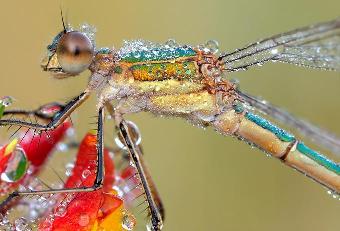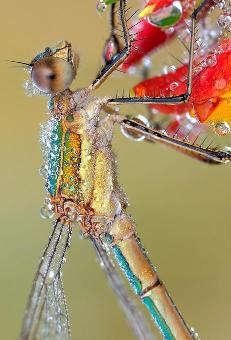Solution: This is almost exactly like our gambler's ruin example except yo uneed to generate random numbers between 1 and 6 inclusive.
makeBlurry that animates filling in a picture with random colors at random locations within the picture.
Have the user pass in as a parameter how many random pixel changes they want to make. Repainting after every pixel change is slow, so have your method repaint every tenth pixel to speed things up (don't use Util.sleep,
that will really slow it down). For example the call, in my solution, the code
below results int the blurry bug by randomly modifying pixels 150,000 times.
String path = "T:/Harcourt/Fall2008/CS140/gallery/"; Picture pic1 = new Picture(path + "bug.jpg"); pic1.makeBlurry(150000);

public void makeBlurry(int count) {
for(int i = 0; i < count; i++) {
// generate a random location
int x = (int)(Math.random()*getWidth());
int y = (int)(Math.random()*getHeight());
// generate a random color
int red = (int) (Math.random()*255);
int green = (int) (Math.random()*255);
int blue = (int) (Math.random()*255);
getPixel(x,y).setColor(new Color(red,green,blue));
// repaint every tenth pixel
if ((i / 10.0) - (i/10) == 0) {
repaint();
}
}
}
flipHorizontal that flips a picture horizontally.
For example, here is the bug flipped horizontally. (Contrast this with the original.)

public Picture flipHorizontal() {
int height = getHeight();
int width = getWidth();
Picture temp = new Picture(width, height);
for (int y = 0; y < height; y++) {
for (int x = 0; x < width; x++) {
Pixel leftPixel = getPixel(x,y);
Pixel rightPixel = temp.getPixel(width - 1 - x, y);
rightPixel.setColor(leftPixel.getColor());
}
}
return temp;
}
rotateLeft that rotates a picture
ninety degrees counter clockwise.
For example, here is the bug rotated left. (Contrast this with the original)

public Picture rotateLeft(){
Picture dest = new Picture(getHeight(), getWidth());
for(int col = 0; col < getWidth(); col ++){
for (int row = 0; row< getHeight(); row++){
Pixel src_pixel = getPixel(col,row);
Pixel dest_pixel = dest.getPixel(row, getWidth() - col -1);
dest_pixel.setColor(src_pixel.getColor());}
}
return dest;
}
morph that changes a picture into another picture from
the top down. For example, assuming pic1 and pic2
are the same exact dimensions
pic1.morph(pic2);will change
pic1 into pic2 row by row starting at the
top.
public void morph(Picture p) {
int height = getHeight();
int width = getWidth();
for (int y = 0; y < height; y++) {
for (int x = 0; x < width; x++) {
Pixel dst = getPixel(x,y);
Pixel src = p.getPixel(x, y);
dst.setColor(src.getColor());
}
repaint();
Util.sleep(.02);
}
}
Picture.java file and work properly so you can use them.